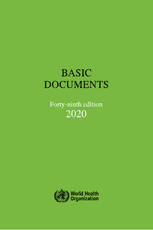Constitution of the World Health Organization (WHO)
The World Health Organization (WHO) constitution, signed at the 1946 International Health Conference, formally acknowledged the right to health as a human right and established the specialized agency of the United Nations to help secure the “highest possible level of health” for all. The WHO’s mandate is to coordinate international health work among different countries through efforts such as disease eradication, standardization of diagnostics and pharmaceutical products, mental and environmental health, and other activities. The WHO Constitution has been amended four times since its inception – the attached document includes those changes.
| Opened for signature | 22 Jul 1946 | ||||||||||||
| Entered into force | 7 Apr 1948 | ||||||||||||
| Latest update | 1 Jan 2020 | ||||||||||||
| Available languages |
|
Related treaties
States parties
All signatories were attendees at the International Health Conference in 1946, all others accessed or definitively signed at a later date.
Country | Status | Signed | Ratified | Entered into force |
|---|---|---|---|---|
| Afghanistan | Party | 19 Apr 1948 | 19 Apr 1948 | |
| Albania | Party | 22 Jul 1946 | 26 May 1947 | 7 Apr 1948 |
| Algeria | Party | 8 Nov 1962 | 8 Nov 1962 | |
| Andorra | Party | 15 Jan 1997 | 15 Jan 1997 | |
| Angola | Party | 15 May 1976 | 15 May 1976 | |
| Antigua and Barbuda | Party | 12 Mar 1984 | 12 Mar 1984 | |
| Argentina | Party | 22 Jul 1946 | 22 Oct 1948 | 22 Oct 1948 |
| Armenia | Party | 4 May 1992 | 4 May 1992 | |
| Australia | Party | 22 Jul 1946 | 2 Feb 1948 | 7 Apr 1948 |
| Austria | Party | 22 Jul 1946 | 30 Jun 1947 | 7 Apr 1948 |
Party
The state has accepted, approved, ratified, or is otherwise party to the agreement, indicating consent to be bound to the agreement.
Signatory
The state has signed, but not yet ratified or become an official party to the agreement. Where the signature is subject to ratification, acceptance or approval, the signature does not establish the consent to be bound. However, it is a means of authentication and expresses the willingness of the signatory state to continue the treaty-making process. The signature qualifies the signatory state to proceed to ratification, acceptance or approval. It also creates an obligation to refrain, in good faith, from acts that would defeat the object and the purpose of the agreement.
Non-party
The state has not taken any actions with regard to the agreement.
Associate member
The state may have requirements for some of the statutory or non statutory aspects of an agreement, but would not confer all of the obligations of the agreement on the member. Associate members may not have voting rights.
Observer
The state is non-party to an agreement, but has the ability to attend meetings or other discussions, and otherwise participate in activities. Observers may be granted permission to speak at formal meetings.




